If you’re like me, you’re looking to get a fair deal on a GPU whenever upgrading. And while I’d love nothing more than to grab something that just came out, realistically, I can’t. So I look through listings of older cards almost daily, waiting for a price drop that I can justify to my wife as an investment in my workplace (my PC), even though I’m only looking for a way to play newer games.
Two cards that often pop up in my searches are the Radeon RX 580 and the GeForce GTX 1650. Being the tech nerd that I am, I compared them, and the results are in this RX 580 vs 1650 comparison. The question is whether old cards such as these are worth purchasing in 2023, now that prices are dropping for newer cards.
RX 580 vs GTX 1650 – Quick Comparison
| RX 580 | Specs | GTX 1650 |
|---|---|---|
| Polaris 20 XTX (215-0910038) | GPU | TU117 (-300-A1) |
| PCIe 3.0 x16 | Interface | PCIe 3.0 x16 |
| 2,304 (Stream Processors) | Cores | 896 (CUDA Cores) |
| 144 | TMUs | 56 |
| 1,257 MHz | Base Clock (Founders Edition) | 1,485 MHz |
| 1,340 MHz | Boost Clock (Founders Edition) | 1,665 MHz |
| 8 GB GDDR5 & 4 GB GDDR5 | Memory | 4GB GDDR5 |
| 2,000 MHz (8 Gbps effective) | Memory Speed | 2,000 MHz (8 Gbps effective) |
| 256.0 GB/s | Bandwidth | 128.1 GB/s |
| 256-bit | Memory Bus | 128-bit |
| 185 W | TDP (Founders Edition) | 75 W |
| 450 W | Required PSU (Founders Edition) | 300 W |
| 75℃ (167℉) | Max Recorded Temp (Founder Edition) | 65℃ (149℉) |
| 45.7dB | Max Fan Noise (Founders Edition) | 45dB |
| 1x HDMI 2.0b 3x DisplayPort 1.4a | Outputs | 1x DVI 1x HDMI 2.0 1x DisplayPort 1.4a |
RX 580
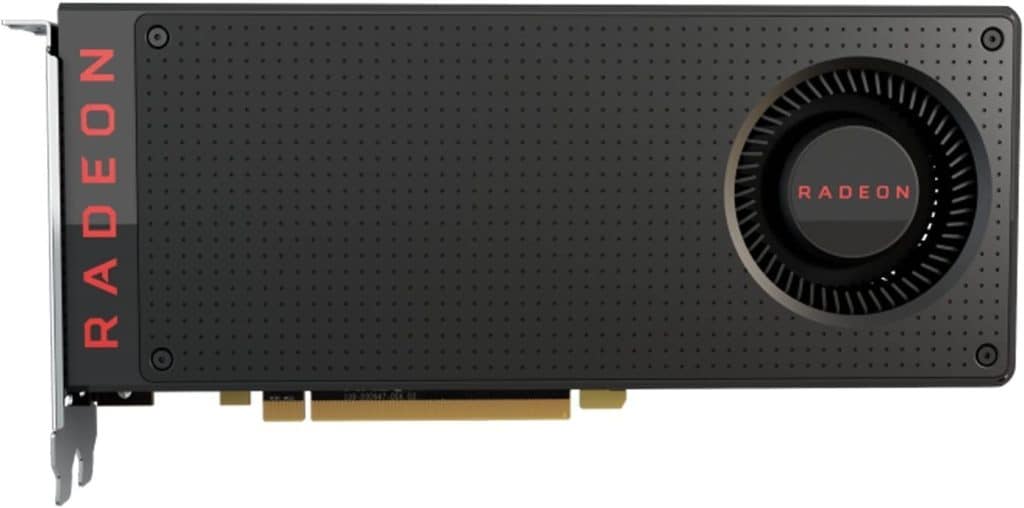
AMD released this mid-range Radeon RX 580 in April 2017, but all modern games run on it thanks to its DirectX 12 support. How well is another matter. It was offered in two versions: an 8 GB and a 4 GB VRAM. It was AMD’s last series to use GCN cores and the first to have HBM2 (High Bandwidth Memory). It was up to 10K, thanks to its HDMI 2.0b port and supported VR.
AMD is a Silicon Valley tech company that designs CPUs, GPUs, motherboard chipsets, cloud infrastructure, and much more. It was founded over 50 years ago and has given us some of the best CPUs to hit the market.
Pros:
- Better performance
- More VRAM
- More cores
- Better performance
Cons:
- Heats up more
- Higher TDP
GTX 1650
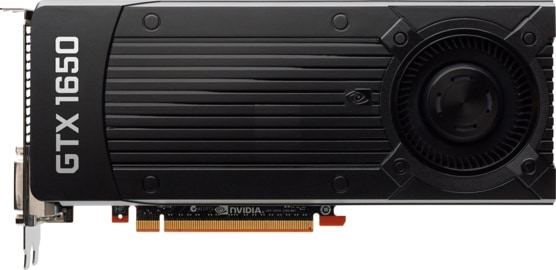
Nvidia released this entry-level GeForce GTX 1650 in February 2019 as part of the GTX 16 series. Based on the Turing architecture, it supports DirectX 12, and thanks to a 2019 update, it even supports DirectX Raytracing. Unfortunately, its fairly high clock speeds are crippled by a low core count, and its 4 GB VRAM isn’t enough for many modern titles.
Nvidia was founded almost 30 years ago to cater to a then-emerging segment — gaming. They produced the first ever GPU and now dominate the market with their RTX GPUs.
Pros:
- Lower TDP
- Produces less heat
- Higher clock speeds
- Lower average price
Cons:
- Smaller VRAM
- Fewer cores
GTX 1650 vs RX 580 – Key Specifications
Architecture
AMD Polaris

Polaris, also known as GCN 4.0, wasn’t the usual breakthrough we see when moving from one GPU generation to the next. Instead, AMD applied improvements in manufacturing that allowed higher clock speeds and better performance. It supports VR, HDR, and DirectX 12, yet it lacked any further updates, which would give it a fighting chance against newer cards as time passed.
Nvidia Turing
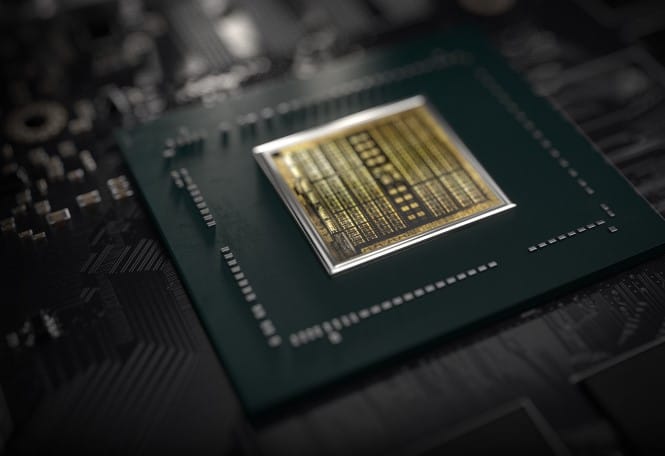
The GeForce 16 series uses the same Turing architecture used in the RTX 20 series. The only difference was the GTX 16 didn’t have Tensor and RT Cores. It was designed as a cheaper alternative to RTX 20 cards, with many of the benefits and a loss of some unessential features. It supported DirectX 12, HDR, VR, and DirectX Raytracing.
Winner: GTX 1650
Also Read: Differences between GTX and RTX Explained
Design and Build
The Founder Editions of both cards are dual-slot cards and have a single-fan design. Third-party variants come in all shapes and sizes, including triple-slot designs, longer versions, and compact single-slot versions.
Winner: Draw
Clock Speeds & Overclocking
Clock speeds are the frequency at which a component (GPU, CPU, RAM, VRAM) operates. Really old cards had one speed, while newer cards have fluctuating speeds. “Base clock” is the default speed, while “boost clock” is the clock speed that a GPU reaches when it needs more performance.
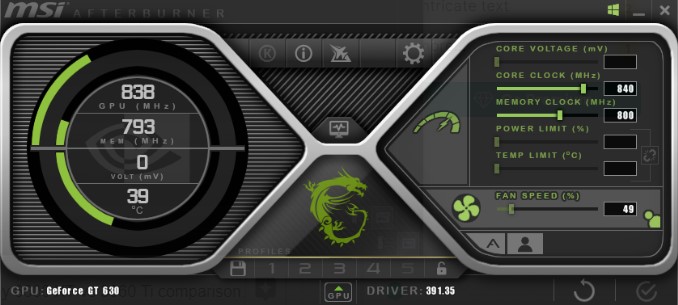
You can go above these speeds through overclocking (OC), using dedicated programs such as AMD software, Nvidia software, or MSI Afterburner. Overclocking shouldn’t be taken lightly; I’ve crashed my cards to their “safe mode clock” (410 MHz) on many occasions. Also, higher clock speeds generate more heat, so be sure to raise fan speeds to counter the heat.
Between the two, the GTX 1650 has higher clock speeds. This goes for both the Founders Editions (FE) of the third-party OC variants. The RX 580 FE has a base clock of 1,257 MHz, while the GTX 1650 FE has 1,485 MHz. The RX 580 FE has a boost speed of 1,340 MHz, and the GTX 1650 FE has 1,665 MHz.
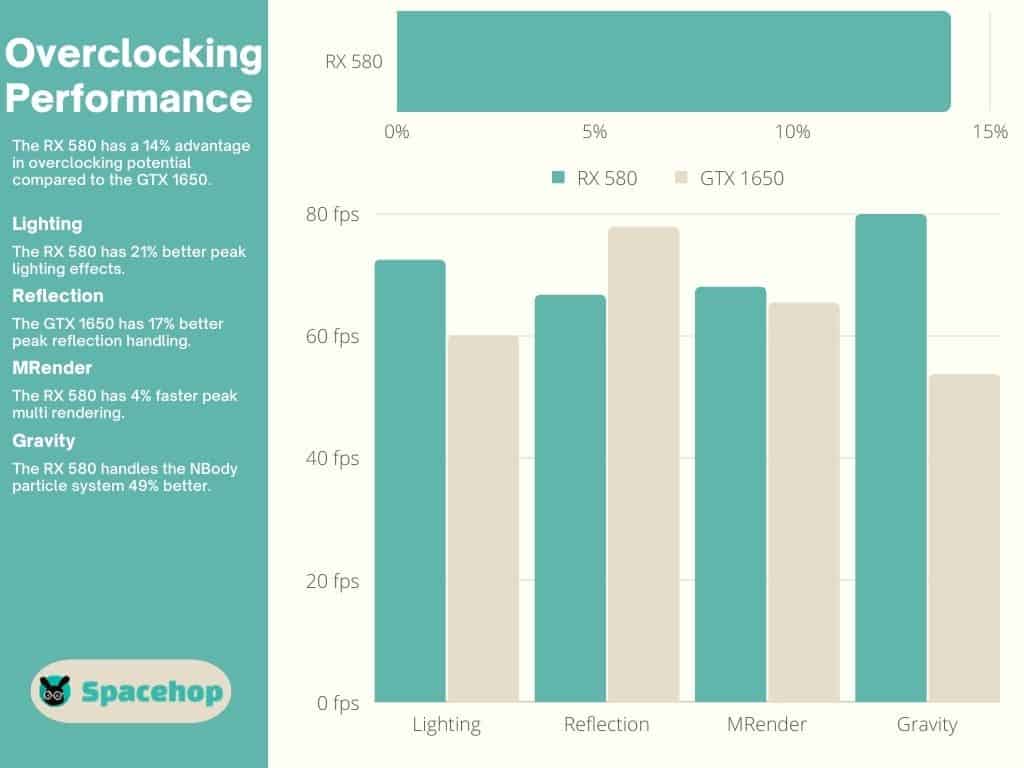
As usual, a lot of third-party variants come factory overclocked at higher speeds. The top five of each are available in the list below. Of the two cards, the RX 580 is the better overclocker, according to user benchmark tests.
Most Powerful Versions
| RX 580 | Boost Clock | GTX 1650 | Boost Clock |
|---|---|---|---|
| 1. Sapphire NITRO+ RX 580 Limited Edition | 1,450 MHz | 1. EVGA GTX 1650 XC Ultra | 1,875 MHz |
| 2. XFX GTR-S RX 580 Black Limited Edition OC+ | 1,450 MHz | 2. Colorful iGame GTX 1650 AD Special OC | 1,860 MHz |
| 3. Dataland DEVIL RX 580 OC | 1,439 MHz | 3. Colorful iGame GTX 1650 Ultra | 1,860 MHz |
| 4. MSI RX 580 GAMING X+ | 1,431 MHz | 4. EVGA GTX 1650 SC Ultra | 1,860 MHz |
| 5. HIS RX 580 XTR IceQ X2 Roaring Turbo | 1,430 MHz | 5. EVGA GTX 1650 XC | 1,860 MHz |
Winner: GTX 1650
Also Read: How to Undervolt your CPU and GPU
Cores
GPUs are parallel processors that handle enormous amounts of data and calculations while rendering 3D environments. Unlike your CPU, GPU cores count in the thousands nowadays, or, in the case of the GTX 1650, hundreds. AMD dominates here with more than double the cores used in the GTX 1650. The RX 580 has 2,304 Stream processors (as they call them). The GTX 1650 has 896 CUDA cores.
Both are the same thing, but Nvidia’s architecture is of a newer series, enabling the GTX 1650 to achieve great performance and high clock speeds with only 896 cores. Nevertheless, the RX 580 has the upper hand due to a sheer volume win.
Winner: RX 580
VRAM & Memory Specs
The RX 580 has an 8 GB GDDR5 VRAM paired with a 256-bit memory BUS. It also comes in a 4 GB version, but that’s not something I’d recommend buying these days, with most games gobbling that much up at minimum requirements.
The GTX 1650 has a 4 GB GDDR5 VRAM paired with a 128-bit memory BUS. This smaller BUS handicaps the GTX 1650 compared to the RX 580, a fact evident in their bandwidths. The RX 580 has 256 GB/s while the GTX 1650 has half — 128.1 GB/s. Even the 4 GB version of the RX 580 has a 256-bit BUS, enabling a bandwidth of 224.0 GB/s, much higher than the GTX 1650.
Winner: RX 580
Also Read: VRAM vs RAM: What are the key differences?
Shaders, Ray Tracing Support, and TMUs
Shaders are generic programs that calculate light, shadows, colors, and more. They leverage the GPU cores to achieve the appropriate results when rendering 3D scenes. The RX 580 has more cores to work with and, thus, better performance. In addition, the GTX 1650 uses a newer shader model allowing it to handle some aspects of rendering better, such as reflections, especially when overclocked.
Ray tracing wasn’t initially supported by either of these cards, even though the GTX 1650’s architecture comes from the RTX 20 series, the first GPU to feature real-time ray tracing cores. Nevertheless, Nvidia decided to enable it on the entire GTX 16 series through an update — DirectX Raytracing. The GTX 1650 never got that type of update.
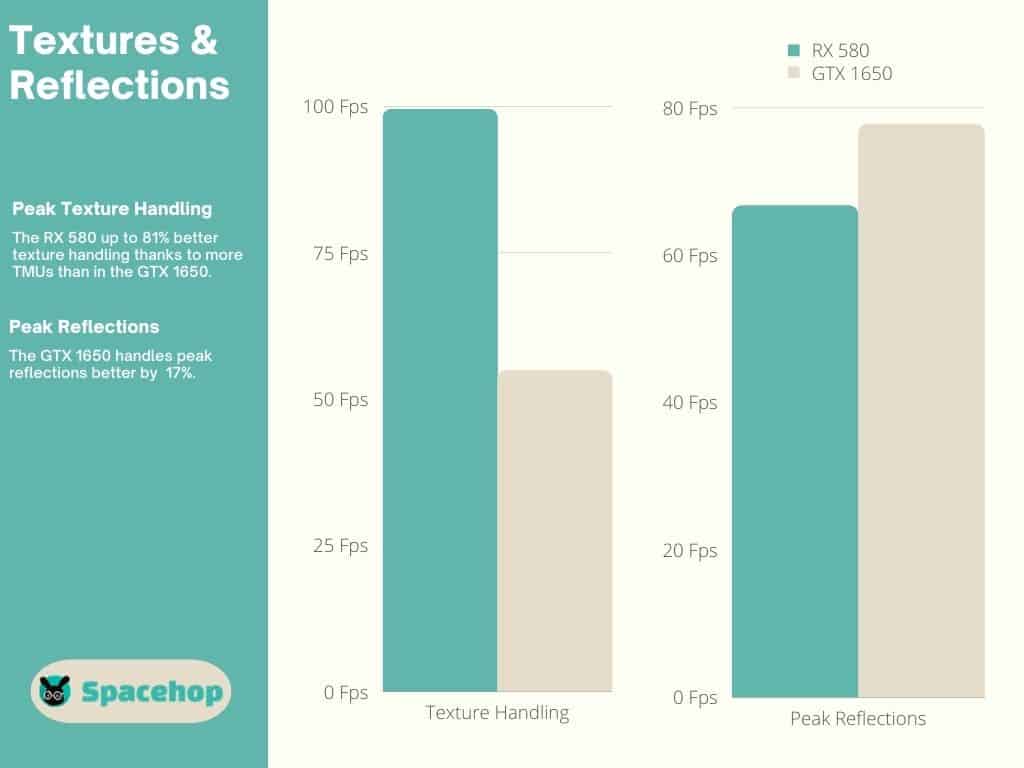
Another critical component of 3D rendering is TMUs or Texture Mapping Units. Their name is self-explanatory — they handle textures in 3D environments, ensuring that every bitmap is precisely and accurately transferred to its corresponding area in a 3D space. The RX 580 has 144 TMUs, while the GTX 1650 has 56. This results in over 80% better peak texture handling by the RX 580.
Winner: Draw
Performance
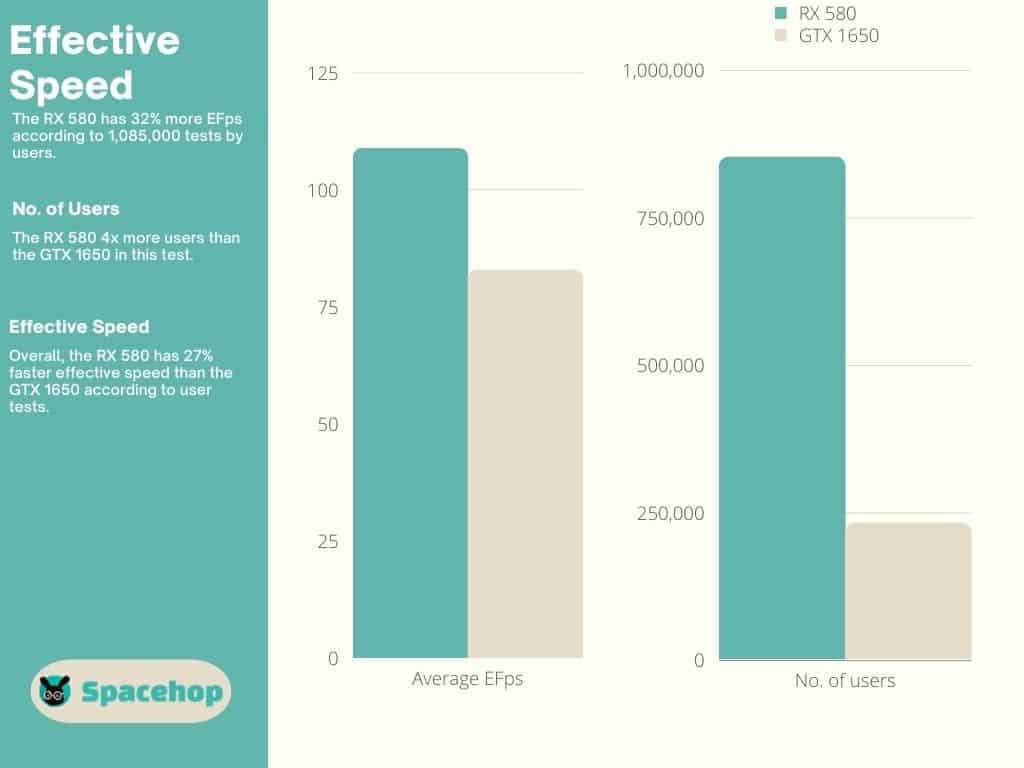
I ran both cards through an 11-game benchmark test with some of the newest titles (forget playing them with either of these) and some older titles (from before and around their releases). I set every setting to Ultra because that’s the way it’s supposed to be played.
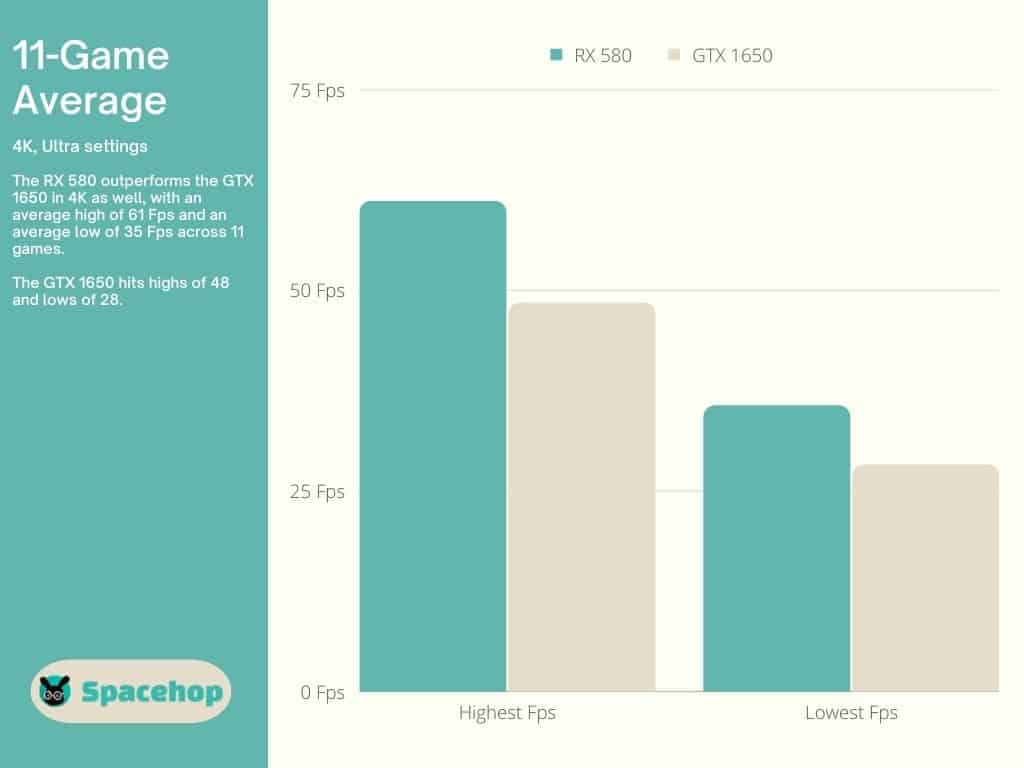
Even though the RX 580 has the hardware to support outputting 10K, it struggles with Fps at 4K, with the lowest of all lows dropping to 12 Fps. The same goes for the GTX 1650, with the lowest Fps at 4K dropping to 9 — a truly unplayable experience. So, what are we left with? Both of these cards do well at 1080p and 1440p, depending on the game, of course, but the RX 580 performs better.
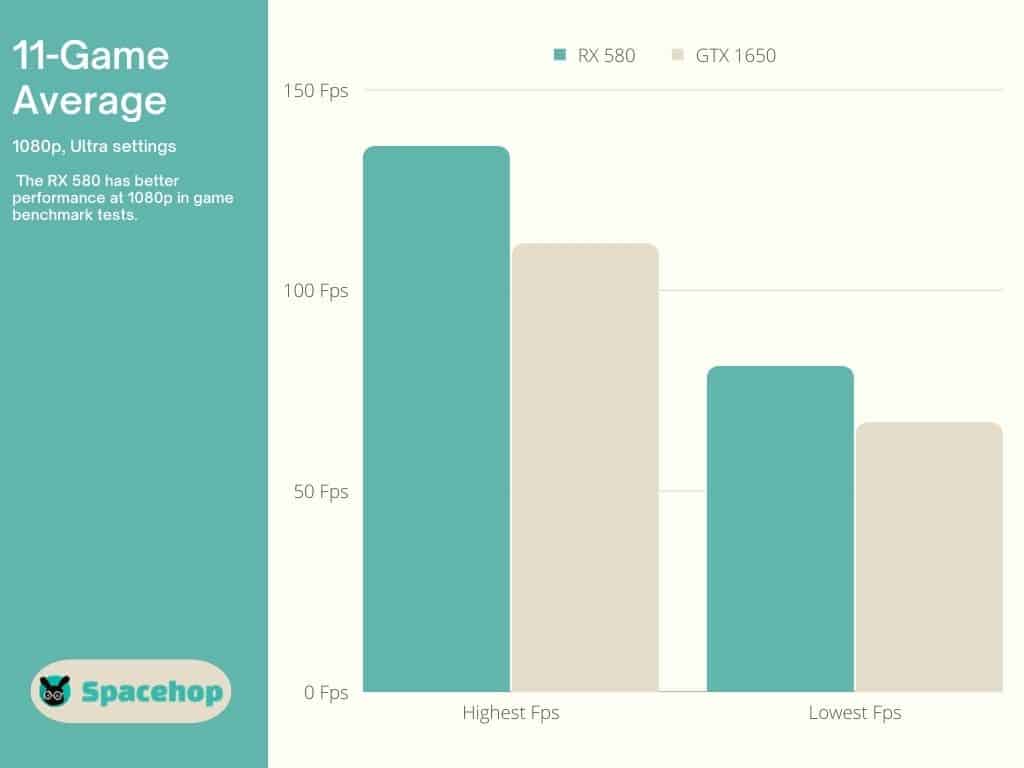
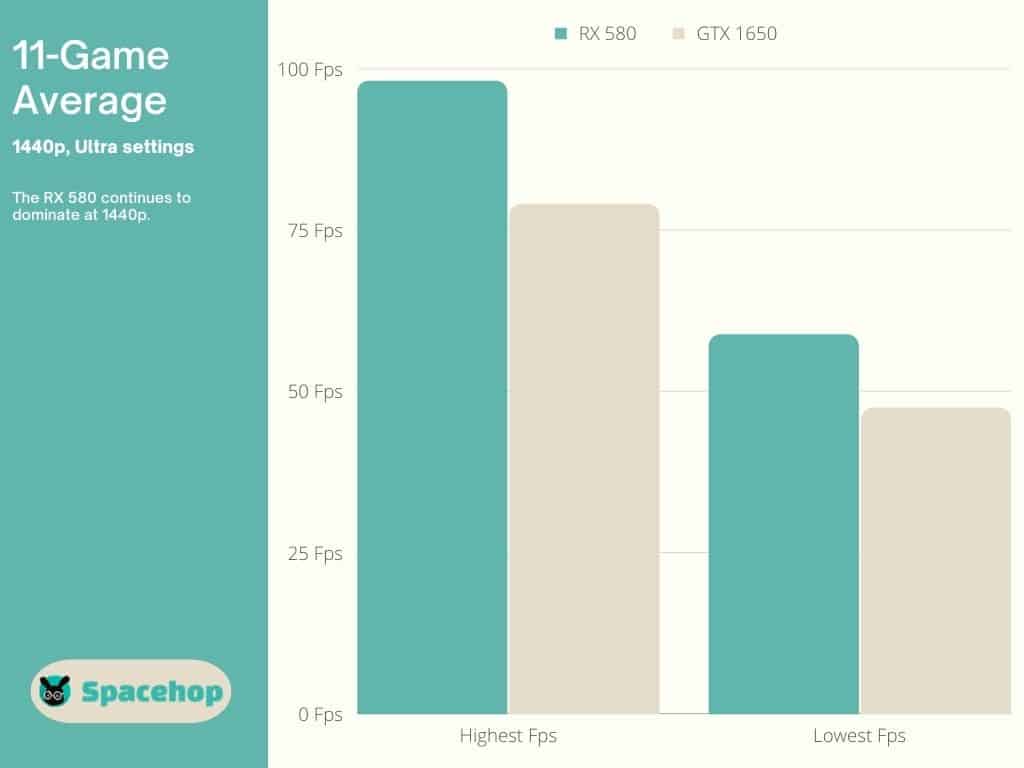
Even at 1080p, some newer titles had Fps as low as 21 (RX 580) and 18 (GTX 1650). At 1440p, the RX 580 performs better as well but still drops as low as 19 Fps. So, if you’re a casual gamer not too keen on trying out the newest games, you’ll do fine with either of these. But if you’re looking for a card that can breeze through a 2022/2023 game, forget both of them.
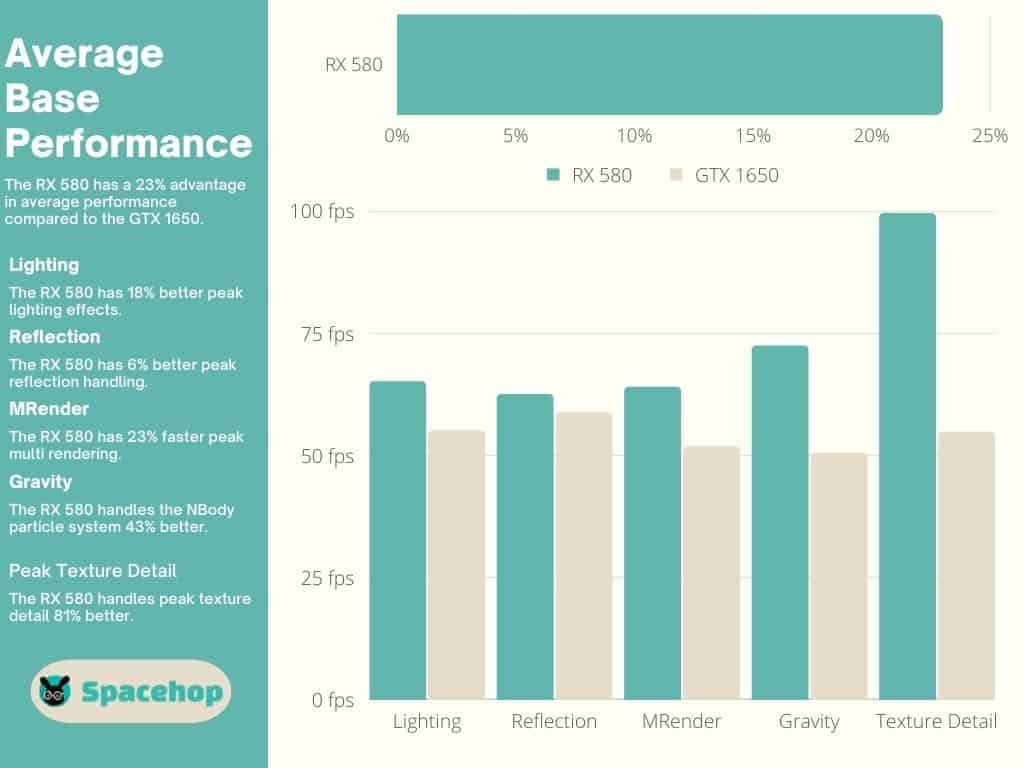
When looking at user test results, we can see that the RX 580 is the better performer by 27%, handles lighting, reflection, and gravity 23% better, and breezes through texture rendering, earning it a decisive win in this segment.
Winner: RX 580
Also Read: 4K vs 1080p Resolution – What’s the difference?
Connectivity
The RX 580 has one HDMI 2.0b port and three 1.4a DisplayPorts. The HDMI 2.0b allows resolutions of up to 10K for UltraWide aspect ratio screens (21:9) at 120Hz. The GTX 1650 has one HDMI 2.0 port (up to 4K @ 60Hz) and one 1.4a DisplayPort. It also has the addition of a DVI port. In terms of connectivity, the RX 580 offers more and better options.
The RX 580 also uses a single 8-pin PSU connector for its 185 W TDP. The GTX 1650 has a lower TDP and doesn’t need an additional power connector, instead drawing all of its power through the PCI port. This is not true of every third-party variant, as many have additional 8 or 6-pin PSU connection ports. Many also have different output configurations, often dropping the DVI port for an additional DisplayPort.
Winner: RX 580
TDP
TDP refers to two things, Thermal Design Power, or how much power a subsystem can draw, and Thermal Design Point — how much heat a subsystem is allowed to produce. AMD cards tend to run hotter than Nvidia cards, by all accounts. The RX 580 requires a 450 Watt PSU to handle its 185 Watt TDP. The GTX 1650 uses only 75 Watts and doesn’t require a PSU over 300 W.
Heat is another matter. The GTX 1650 runs 10℃ (50℉) cooler than the RX 580 at full load, maxing out at 65℃ (167℉). The RX 580 reaches up to 75℃ (167℉) at full load. AMD cards are notorious for heating up quickly, then throttling performance while heat is dissipated. These temperatures correspond to the Founders Editions, not the overclocked third-party variants.
Winner: Draw
RX 580 vs 1650 – Standout Features
RX 580 Output configuration
The RX 580 supports four peripherals. The GTX 1650 supports three.
Pricing & Availability
The RX 580 (8 GB) was released with a $229 MSRP. The GTX 1650 was released with a $149 MSRP. Today, the RX 580 is most often sold above MSRP, sometimes far above. The prices of the GTX 1650 are now hovering slightly above the original MSRP.
You can grab an overclocked XFX GTS Edition just above the original MSRP or this XFX GTS variant for slightly more (more in stock). The best deal by far for an RX 580 is this PowerColor VGA variant, 9% below MSRP.
Sapphire seems to be selling for the highest prices. This Sapphire Pulse variant is 65% above the MSRP, while this Sapphire Pulse variant is 144% above the MSRP. Unjustifiable, in my opinion. Especially when you consider that you can now grab an RTX 3060 or an RX 6600 XT for below $400 on sale.
While some RX 580s can be found below MSRP, every GTX 1650 variant is currently sold above. For example, prices range from 13% above MSRP for a Zotac Gaming variant, 23% above for an MSI Gaming card, 26% above for an EVGA Ultra Gaming card, all the way up to 40% above for variants from ASUS (ASUS, ASUS Phoenix).
Conclusion
So, are they worth it in 2023? Not really. This GTX 1650 vs RX 580 comparison tells us that neither of these cards can really handle ultra settings at 1080p except in older titles, let alone 1440p or 4K. The RX 580 is the better performer, but its prices are unjustifiable if you ask me (from a gaming point of view).
Nevertheless, if you’re a casual gamer that enjoys playing older titles, you could grab one of the lower-priced variants I listed here and be satisfied playing any older title.